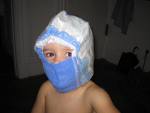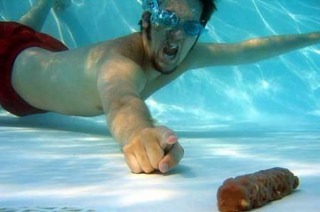Growing up in late-1960s suburbia, I had a turtle.
 Turtles were inexpensive, popular, and low maintenance, with an array of groovy pre-molded plastic housing designs to choose from. Invariably they would escape, only to be found days later behind the couch along with the skeleton of the class bunny my younger sister brought home from kindergarten one weekend.
Turtles were inexpensive, popular, and low maintenance, with an array of groovy pre-molded plastic housing designs to choose from. Invariably they would escape, only to be found days later behind the couch along with the skeleton of the class bunny my younger sister brought home from kindergarten one weekend.
But eventually, replacement turtles became harder to come by. Reports started surfacing that people with pet turtles were getting sick. In 1975, the U.S. Food and Drug Administration (FDA) banned commercial distribution of turtles less than 4 inches in length, and it has been estimated that the FDA ban prevents some 100,000 cases of salmonellosis among children each year.
Maybe I got sick from my turtle.
Maybe I picked up my turtle, rolled around on the carpet with it, pet it a bit, and then stuck my finger in my mouth. Maybe in my emotionally vacant adolescence I kissed my turtle. Who can remember?
.jpg) A report that will be published tomorrow in the journal Pediatrics documents how 107 people in 34 states became sick with Salmonella from the small turtles between 2007 and 2008 – including two girls who swam with pet turtles in a backyard pool.
A report that will be published tomorrow in the journal Pediatrics documents how 107 people in 34 states became sick with Salmonella from the small turtles between 2007 and 2008 – including two girls who swam with pet turtles in a backyard pool.
The paper notes that one-third of all patients had to be hospitalized, and in many cases, parents didn’t know turtles could carry salmonella.
Julie Harris, a scientist at the U.S. Centers for Disease Control and Prevention and the report’s lead author said other cases turned up elsewhere, many involving direct contact with turtles, including children kissing turtles or putting them in their mouths.
I’m familiar with that.
David Bergmire-Sweat, a North Carolina epidemiologist who investigated the Union County case, said he’s heard of families letting turtles walk on kitchen surfaces where food is prepared, and babies being bathed in sinks where turtle cages are washed.
.jpg) Veterinarian Mark Mitchell, a University of Illinois zoological medicine professor, has been working with Louisiana turtle farmers in research aimed at raising salmonella-free turtles, says the industry has been unfairly saddled with harsher restrictions than producers of human foods also blamed for recent salmonella outbreaks.
Veterinarian Mark Mitchell, a University of Illinois zoological medicine professor, has been working with Louisiana turtle farmers in research aimed at raising salmonella-free turtles, says the industry has been unfairly saddled with harsher restrictions than producers of human foods also blamed for recent salmonella outbreaks.
Maybe, but people need to eat. They don’t need to kiss turtles.
 feces on the toddler slide on Aug. 22, 2009.
feces on the toddler slide on Aug. 22, 2009.
.jpg) Manhattan (Kansas) tomorrow, but the new public pool at the park down the street with the psychedelic water slide configuration won’t be open for a few months (whoever designed the
Manhattan (Kansas) tomorrow, but the new public pool at the park down the street with the psychedelic water slide configuration won’t be open for a few months (whoever designed the  pool codes and, therefore, inspection items differed across jurisdictions, reported denominators varied. Of 111,487 inspections, 13,532 (12.1%) resulted in immediate closure because of serious violations (e.g., lack of disinfectant in the water). Of 120,975 inspections, 12,917 (10.7%) identified disinfectant level violations.
pool codes and, therefore, inspection items differed across jurisdictions, reported denominators varied. Of 111,487 inspections, 13,532 (12.1%) resulted in immediate closure because of serious violations (e.g., lack of disinfectant in the water). Of 120,975 inspections, 12,917 (10.7%) identified disinfectant level violations.  The supermarket specialises in retailing products to the Afghan community.
The supermarket specialises in retailing products to the Afghan community. Turtles were inexpensive, popular, and low maintenance, with an array of groovy pre-molded plastic housing designs to choose from. Invariably they would escape, only to be found days later behind the couch along with the skeleton of the class bunny my younger sister brought home from kindergarten one weekend.
Turtles were inexpensive, popular, and low maintenance, with an array of groovy pre-molded plastic housing designs to choose from. Invariably they would escape, only to be found days later behind the couch along with the skeleton of the class bunny my younger sister brought home from kindergarten one weekend. .jpg) A report that will be published tomorrow
A report that will be published tomorrow.jpg) Veterinarian Mark Mitchell, a University of Illinois zoological medicine professor, has been working with Louisiana turtle farmers in research aimed at raising salmonella-free turtles, says the industry has been unfairly saddled with harsher restrictions than producers of human foods also blamed for recent salmonella outbreaks.
Veterinarian Mark Mitchell, a University of Illinois zoological medicine professor, has been working with Louisiana turtle farmers in research aimed at raising salmonella-free turtles, says the industry has been unfairly saddled with harsher restrictions than producers of human foods also blamed for recent salmonella outbreaks..jpg)
 Saha was making an inspection of the hostel’s kitchen after 63 students, who had taken lunch there on Saturday, underwent treatment for food poisoning at Bagerhat Sadar Hospital.
Saha was making an inspection of the hostel’s kitchen after 63 students, who had taken lunch there on Saturday, underwent treatment for food poisoning at Bagerhat Sadar Hospital. Last year, with Amy’s guidance, was the first year I really started cooking with fresh herbs. Basil and tomato (and formerly cheese, right), fresh pesto, bruschetta, it’s all good.
Last year, with Amy’s guidance, was the first year I really started cooking with fresh herbs. Basil and tomato (and formerly cheese, right), fresh pesto, bruschetta, it’s all good..jpg) The
The  Swim diapers released about 50% of the microspheres within one minute. A vinyl diaper cover placed over a disposable swim diaper slightly improved performance. Still, over 25% were released into the water within two minutes.
Swim diapers released about 50% of the microspheres within one minute. A vinyl diaper cover placed over a disposable swim diaper slightly improved performance. Still, over 25% were released into the water within two minutes.  “Her mother decided that there was no room in the fridge, so she did the next best thing, throwing the turkey into the swimming pool to thaw. It wasn’t heated, so the water was in the low 60s. The good news is that we convinced mom to rescue the bird from the pool. The bad news — we did not get a picture of the floating turkey.”
“Her mother decided that there was no room in the fridge, so she did the next best thing, throwing the turkey into the swimming pool to thaw. It wasn’t heated, so the water was in the low 60s. The good news is that we convinced mom to rescue the bird from the pool. The bad news — we did not get a picture of the floating turkey.” Here’s Steve in action with some visiting Russian team. As Chapman correctly notes, this photo perfectly exhibits Naylor:
Here’s Steve in action with some visiting Russian team. As Chapman correctly notes, this photo perfectly exhibits Naylor: